Sōtatsu: Making Waves exhibition
Collections in the U.S. and Japan, including Waves at Matsushima, shown together as well as works by Sōtatsu-related artists
There was a symposium held on Sunday, March 22, 2015 in Tokyo. It can be viewed via Youtube.
The Japan Foundation, in cooperation with the Freer Gallery of Art and Arthur M. Sackler Gallery, the Asian art museums at the Smithsonian Institution (Washington, D.C.), will organize the Sōtatsu: Making Waves exhibition focusing on the works by this Japanese artist of the early Edo period. The exhibition will open on October 24, 2015 run through January 31, 2016.
This exhibition will present approximately 50 works by Sōtatsu and his circle of painters, renowned for their decorative style, along with around 15 modern era paintings from the 1910s onwards (Taishō and later eras) that were influenced by Sōtatsu, to provide a clear sense of how Sōtatsu’s arts continue to resonate with artists even today.
The exhibition is organized as a part of the five-year initiative based on the fact sheet issued by the Japanese and the U.S. governments in November 2010 ("Strengthening the exchange between Japan and U.S. for further deepening the Japan-U.S. Alliance"(PDF:External link)).
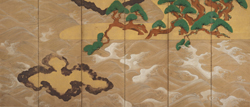
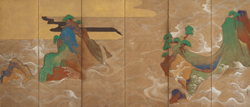
Tawaraya Sōtatsu, Waves at Matsushima
Early 1600s
Color on paper, pair of six-panel screens
Freer Gallery of Art, Smithsonian Institution, Washington, DC: Gift of Charles Lang Freer, F1906.231-232
Read an essay written by the exhibition’s co-curator James T. Ulak in Wochi Kochi Magazine
Outline
| Date | Saturday, October 24, 2015 - Sunday, January 31, 2016 *Open 10 a.m. to 5:30 p.m. every day except December 25 |
|---|---|
| Venue | Arthur M. Sackler Gallery (Washington, DC) |
| Co-organized by | The Japan Foundation The Freer Gallery of Art and Arthur M. Sackler Gallery, Smithsonian Institution, Washington, DC |
| Special Support | The University Art Museum, Tokyo University of the Arts |
| Supported by | ALL NIPPON AIRWAYS CO.,LTD. |
| Curated by | Ryō Furuta (Associate Professor at The University Art Museum - Tokyo University of the Arts), James Ulak (Senior Curator of Japanese Art at the Freer Gallery of Art and Arthur M. Sackler Gallery) |
| Advisory Committee | Syunroku Okudaira (Professor at Graduate School of Letters, Osaka University), Keiko Nakamachi (Professor at Jissen Women's University), Yukio Lippit (Professor at Harvard University) |
Sōtatsu: The Painter Who Remains the Greatest Mystery in Japanese Art History
Tawaraya Sōtatsu, renowned for his masterpieces designated as National Treasures (such as Wind God and Thunder God screens, Water Fowl in the Lotus Pond and Scenes from Sekiya and Miotsukushi Chapters of The Tale of Genji) and numerous works designated as Important Cultural Properties. Sōtatsu was active in Kyoto in the first half of the 17th century and is considered to be one of the most important painters in the history of Japanese art. However, almost nothing is known about his life. Indeed, he can be called a mysterious painter.
Sōtatsu is thought to have developed his Tawaraya studio through interactions with intellectuals, including Hon’ami Kōetsu (1558–1637) and Suminokura Soan (1571–1632), both associated with Kyoto’s wealthy town merchants, court aristocrats and Buddhist priests. In his early period Sōtatsu created fan paintings and decorated writing papers, but later he produced larger scale works such as folding screens and wall panel paintings.
Freer and Sōtatsu
Two of Sōtatsu’s greatest works, the Waves at Matsushima screens and the Dragons and Clouds screens are in the collection of the Freer Gallery of Art, Washington, D.C. Undoubtedly if these works were in Japan the government would have designated them as National Treasures. Charles Lang Freer (1854–1919) made his fortune by building rail cars. After retiring in his mid-forties he shifted his energies to art collecting. He visited Japan many times, acquiring works of Japanese art, primarily of the early modern era. The quantity and quality of his collection rivals that of the Museum of Fine Arts, Boston. The two Sōtatsu works are major examples of that quality. However, when he donated his collection to the U.S. government he made the stipulation that none of the works could be lent outside the museum. This has meant that art lovers must visit the Freer Gallery of Art in order to see those masterpieces.
Sōtatsu in the 20th Century
Ogata Kōrin took Sōtatsu as his artistic model, and Sakai Hōitsu modeled his work after that of Kōrin. These artists came to be known as the Rimpa lineage in the late Meiji period. Surprisingly, Sōtatsu was not generally known until the Taishō period (1912–1926). Freer purchased his two Sōtatsu works prior to this general recognition, and this purchase made him as a pioneer in the understanding of Sōtatsu’s arts.
From the Taishō era onwards, essentially the majority of the 20th century, many Japanese painters have been fascinated by Sōtatsu’s richly individualistic expression. These artists include Shikō Imamura, Kokei Kobayashi, Hyakusui Hirafuku, Heihachirō Fukuda, Hōshun Yamaguchi, Seison Maeda and Yuki Ogura. Rather than simply copying Sōtatsu, they experimented with revealing the contemporary fascination with Sōtatsu through their own unique forms of expression.
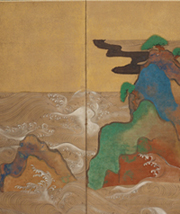
Tawaraya Sōtatsu, Waves at Matsushima(part)
Early 1600s
Color on paper, pair of six-panel screens
Freer Gallery of Art, Smithsonian Institution,
Washington, DC: Gift of
Charles Lang Freer, F1906.231-232
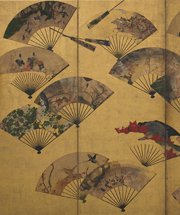
Tawaraya Sōtatsu, Screen with Scattered Fans (part)
Early 1600s
Color on paper, six-panel screen
Freer Gallery of Art, Smithsonian Institution,
Washington, DC: Gift of Charles Lang Freer, F1900.24
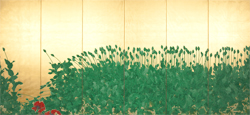
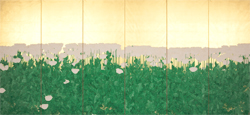
Seison Maeda, Poppies
1930
Color on paper, pair of six-panel screens
Hikaru Museum
©Y.MAEDA & JASPAR, Tokyo, 2014 E1289
Catalog
This exhibition catalogue includes various works by Sōtatsu and his circle of painters, along with modern era paintings from the 1910s onwards (Taishō and later eras) that were influenced by Sōtatsu.
- Contributors of texts: Yukio Lippit and James T. Ulak
- Publisher: Smithsonian Books (Published in November, 2015)
- Total pages: 368 pages
- Language: English
- Size: 25.4 x 3.6 x 30 cm
- Price: USD 50.00
- *Available on Amazon.com and other online bookstores.
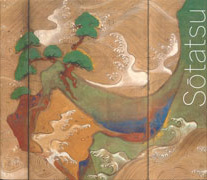
[Contact Us]
The Japan Foundation
International Operations Section 1, Arts and Culture Dept.
Tel: +81-(0)3-5369-6061 Fax: +81(0)3-5369-6038
Person in charge: Miki Okabe (Ms.), Etsuko Yamada (Ms.), Michiko Yuhashi (Ms.)
E-mail: Miki_Okabe@jpf.go.jp / Etsuko_Yamada@jpf.go.jp / Michiko_Yuhashi@jpf.go.jp
(When sending an e-mail, please enter a half-width character "@" instead of a full-width character "@.").
- What We Do Top
- Arts and Cultural Exchange [Culture]
- Japanese-Language Education Overseas [Language]
- Japanese-Language Education Overseas [Language] Top
- Learn Japanese-language
- Teach Japanese-language
- Take Japanese-Language Test
- Know about Japanese-language education abroad
- The Japanese-Language Institute, Urawa
- The Japanese-Language Institute, Kansai
- Japanese-Language Programs for Foreign Specified Skilled Worker Candidates
- Japanese Language Education for Japanese Children Resident Overseas and for the Descendants of Migrants
- Archives
- Japanese Studies and Global Partnerships [Dialogue]
- JF digital collection
- Other Programs / Programs to Commemorate Exchange Year
- Awards and Prizes
- Publications
